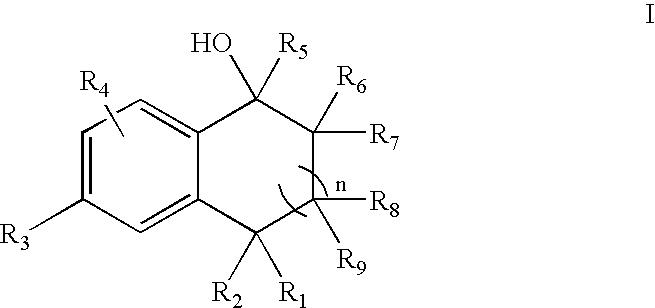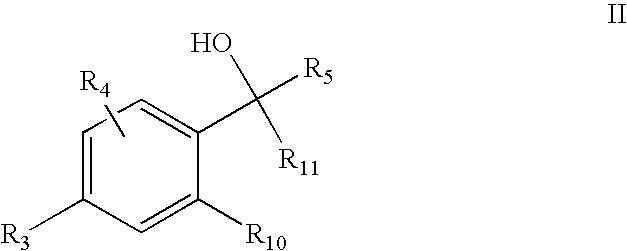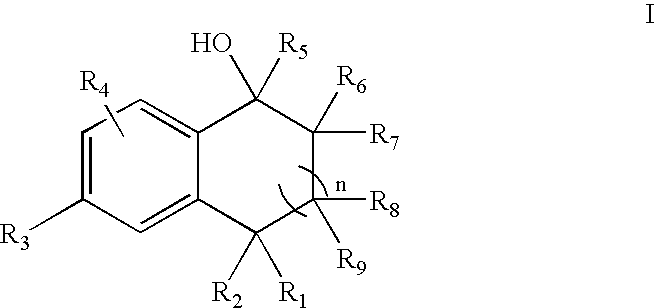5-Aryl-indan-1-ol and analogs useful as progesterone receptor modulators
a technology of progesterone receptor and aryl indan-1, which is applied in the field of agonists and antagonists of the progesterone receptor, can solve the problems of increasing the risk of uterine cancer
- Summary
- Abstract
- Description
- Claims
- Application Information
AI Technical Summary
Benefits of technology
Problems solved by technology
Method used
Image
Examples
example 1
5-[4-(1-hydroxyethyl)phenyl]-1-methyl-1H-pyrrole-2-carbonitrile
[0120] To a stirred solution of 1-methyl-2-cyanopyrrole (1.6 g, 15 mmol) and triisopropyl borate (7.0 mL, 30 mmol) in THF (45 mL) at 0° C. was added lithium diisopropyl amide (LDA, 2.0 M in heptane / THF / ethylbenzene, 13.3 mL, 26.6 mmol) in a dropwise fashion over 45 minutes. The resulting solution was stirred at 0° C. for 1 hour. To the solution was added 1-(4-bromophenyl)-ethanone (1.0 g, 5 mmol) dissolved in glyme (45 mL), sodium carbonate (1.59 g, 15 mmol) dissolved in water (9 mL), and tetrakis(triphenylphosphine) palladium (0) (0.28 g, 0.25 mmol). The resulting solution was heated to reflux for 1.5 hours. The solution was cooled to room temperature and partitioned between a saturated aqueous ammonium chloride solution (50 mL) and ethyl acetate (80 mL). The organic layer was separated, dried over magnesium sulfate, filtered, and concentrated. The residue was purified on a silica gel column (20% ethyl acetate in hexan...
example 2
5-(1-hydroxy-3-methyl-2,3-dihydro-1H-inden-5-yl)-1-methyl-1H-pyrrole-2-carbonitrile
[0122] To a mixture of sodium chloride (1.23 g, 21.0 mmol) and aluminum chloride (5.0 g, 38.2 mmol) at 130° C. was added 1-(4-bromophenyl)-4-chlorobutan-1-one (1.0 g, 3.82 mmol) and the resulting mixture was heated to 180° C. for 20 minutes. The mixture was allowed to cool to room temperature and poured into a cold aqueous 1N HCl solution. The mixture was extracted several times with dichloromethane. The combined organic layers were separated, dried over magnesium sulfate, filtered and concentrated to give 5-bromo-3-methyl-indan-1-one (0.77 g, 89%).
[0123] 1-Methyl-5-(3-methyl-1-oxo-2,3-dihydro-1H-inden-5-yl)-1H-pyrrole-2-carbonitrile was then prepared from 5-bromo-3-methyl-indan-1-one and 1-methyl-2-cyanopyrrole according to the coupling procedure as described in example 1 as an orange solid. MS (ES) m / z 251.2; Anal. Calcd for C16H14N2O: C, 76.78; H, 5.64; N, 11.19. Found: C, 76.49; H, 5.49; N, 11.1...
example 3
5-(1-hydroxy-3,3-dimethyl-2,3-dihydro-1H-inden-5-yl)-1-methyl-1H-pyrrole-2-carbonitrile
[0125] To a stirred solution of 1-(4-hydroxyphenyl)-3-methylbut-2-en-1-one (1.0 g, 5.67 mmol) in dichlorobenzene (50 mL) was added aluminum chloride (1.97 g, 14.74 mmol). The mixture was heated to 150° C. for 4 hours. After cooling to room temperature, the reaction mixture was poured over ice and extracted with dichloromethane (3×80 mL). The organic layers were combined, dried over magnesium sulfate, filtered, and concentrated. The residue was purified on a silica gel column (20% ethyl acetate in hexane) to give 5-hydroxy-3,3-dimethylindan-1-one as a tan solid (0.32 g, 32%). MS m / z 177.
[0126] A solution of 5-hydroxy-3,3-dimethylindan-1-one in anhydrous pyridine at 0° C. was treated with triflic anhydride under an atmosphere of nitrogen. After completion of the reaction, which was indicated by thin layer chromatography, the reaction solution was poured onto a mixture of ice and 6N aqueous HCl sol...
PUM
| Property | Measurement | Unit |
|---|---|---|
| temperature | aaaaa | aaaaa |
| temperature | aaaaa | aaaaa |
| temperature | aaaaa | aaaaa |
Abstract
Description
Claims
Application Information
 Login to View More
Login to View More - R&D
- Intellectual Property
- Life Sciences
- Materials
- Tech Scout
- Unparalleled Data Quality
- Higher Quality Content
- 60% Fewer Hallucinations
Browse by: Latest US Patents, China's latest patents, Technical Efficacy Thesaurus, Application Domain, Technology Topic, Popular Technical Reports.
© 2025 PatSnap. All rights reserved.Legal|Privacy policy|Modern Slavery Act Transparency Statement|Sitemap|About US| Contact US: help@patsnap.com



